The term “hot pepper” includes thousands of cultivars of peppers in the Capsicum genus that exhibit a wide range of peppery heat, from mild to spicy to mind-bogglingly hot.
This guide will discuss 10 types of hot peppers, their characteristics, and how they stack up on the Scoville scale.
So, get a cool, soothing drink ready cause we’re jumping into the wild world of hot peppers!
What Are Hot Peppers?
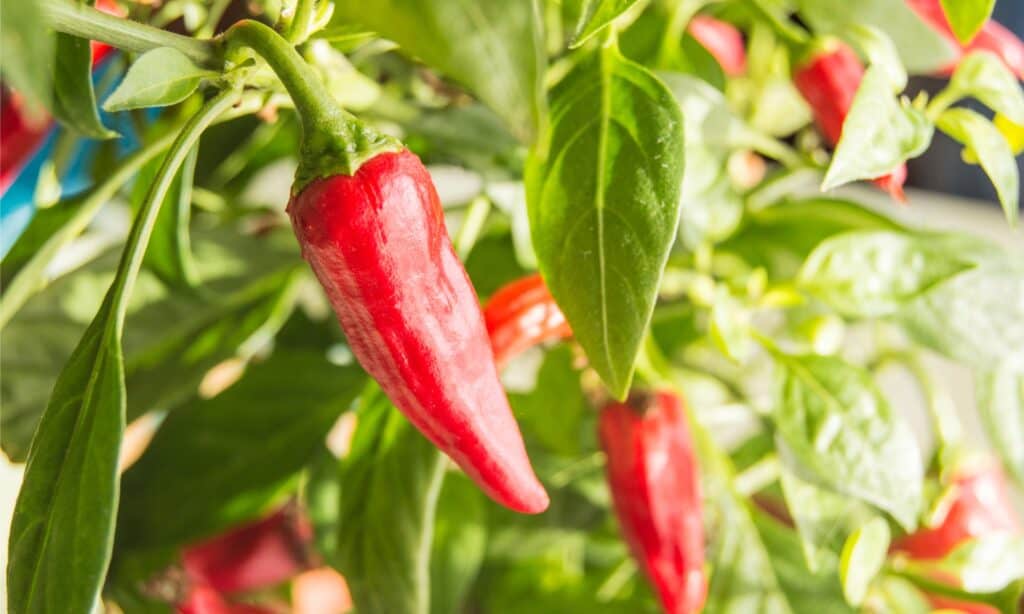
There are thousands of types of hot peppers.
©iStock.com/ClaireLucia
Before we start ranking our list, let’s make sure we’re on the same page about the botanical definition of hot pepper. Botanically speaking, a hot pepper is any naturally-occurring variety or cultivar containing capsaicin and belongs to the Capsicum genus of peppers. Today, some of the most commonly cultivated species are Capsicum annuum, Capsicum frutescens, Capsicum pubescens, and Capsicum chinense. Many hot peppers sold on the market today are also crosses of these species.
10 Types Of Hot Peppers: Botanical Classification, Characteristics, And Scoville Ranking
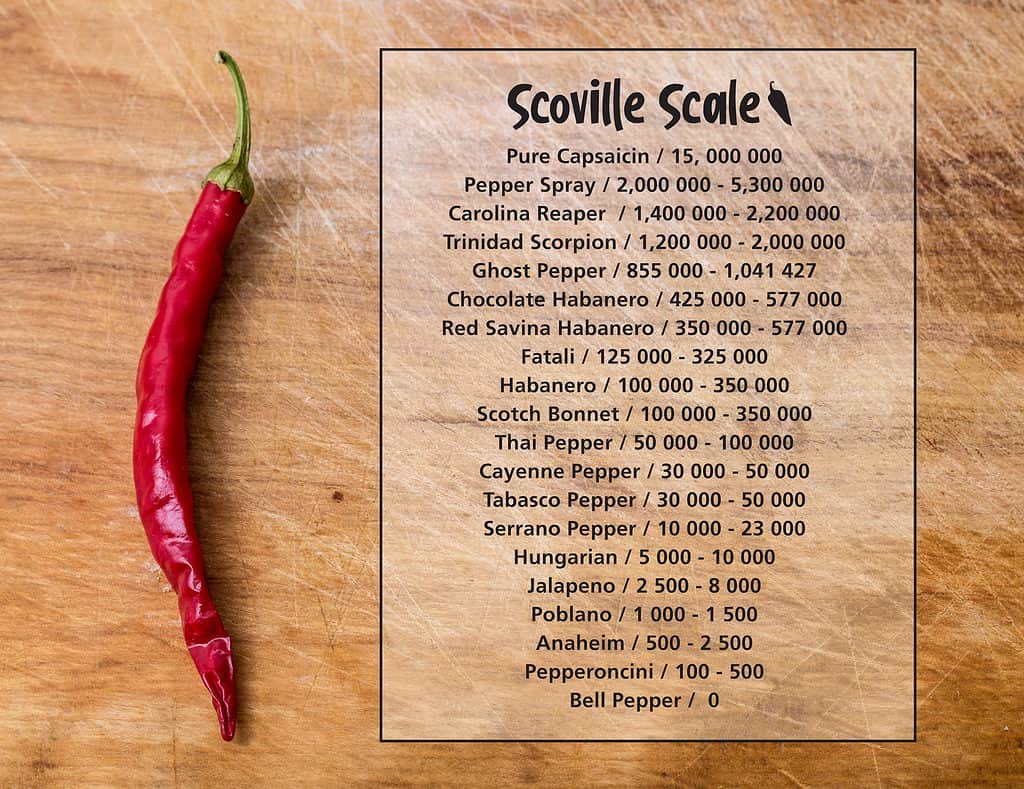
The Scoville Scale helps rank peppers’ heat levels.
©julie deshaies/Shutterstock.com
Some hot peppers only produce a mild sensation of heat, while others are genuinely painful to eat and cause several physiological responses to ingestion. The more capsaicin a pepper contains, the hotter it tastes, and for most people, the more your system may react to this spicy compound.
Typical symptoms and physiological responses to eating hot peppers can include:
- Burning sensation (to various degrees) of the mouth, nose, throat, and stomach.
- Runny nose and watering eyes
- Coughing
- Hiccuping
- Sweating
- Vomiting
- Diarrhea
Reactions vary widely by the individual. Some folks have a quite low tolerance to capsaicin, while others relish it and consume the hottest peppers they can get their hands on with seemingly little bodily repercussions.
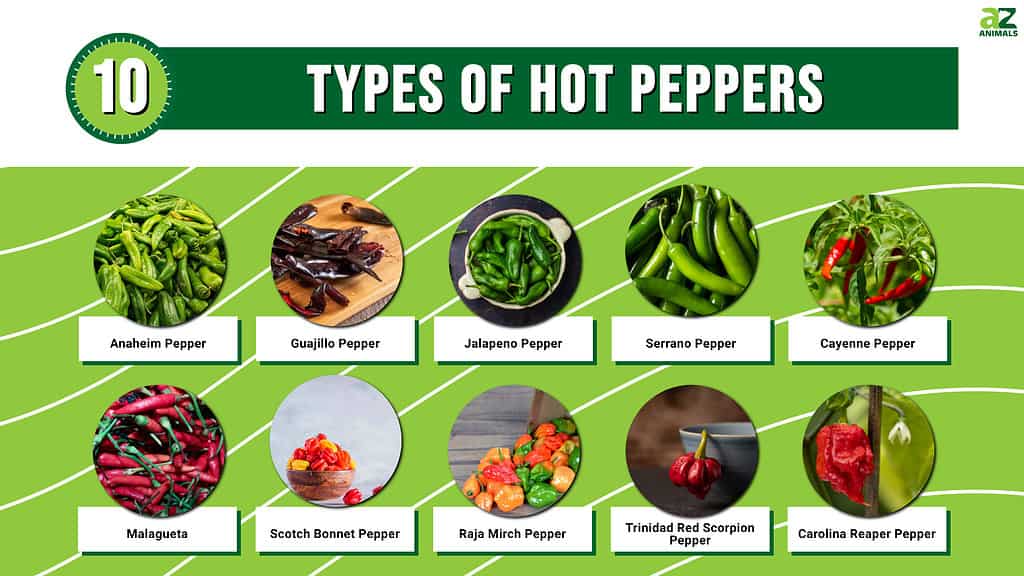
What Is The Scoville Scale?
Developed in 1912 by pharmacist Wilbur Scoville, the Scoville scale measures hot peppers’ spiciness through capsaicin dilution and taste testing. To quantify the spiciness of a pepper, you must obtain an extract of capsaicin oil from the dried pepper. This extract is then diluted in a set volume of sugar water at an increasing ratio until professionally trained taste testers can no longer detect the capsaicin. When the taste testers can no longer detect any spiciness, a Scoville heat unit (SHU) is assigned to the pepper, reflecting how much the concentration needed to be diluted. So, if a certain hot pepper has a 20,000 Scoville rating, this means one drop of the pepper’s oil was only undetectable after mixing with 20,000 drops of sugar water.
Ranking 10 Types Of Hot peppers
For this guide, we’ll use the Scoville scale to rank 10 types of hot peppers, in ascending order of spiciness.
1. Anaheim Pepper (Capsicum annuum ‘Anaheim’)
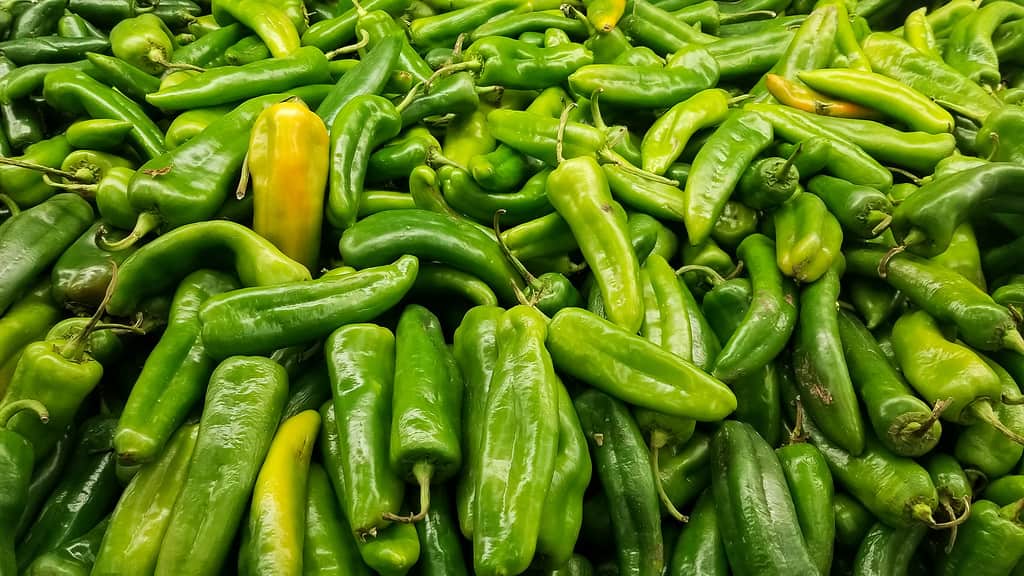
Anaheim peppers are named after Anaheim, California.
©iStock.com/David Bautista
The first hot pepper on our list originated in New Mexico but became widely popularized by a farmer in Anaheim, California. It’s well-loved as a mildly hot pepper that adds a pleasant kick to various dishes. This chili pepper is medium-sized, averaging 6-10 inches in length. Generally, you cook these types of hot peppers when they’re still green. Stuffing it with rice, cheese (vegan or dairy-based), and protein is a popular dish.
Scoville Rating: The ‘Anaheim’ pepper is a mildly hot pepper with a Scoville heat rating, depending on the cultivar, between 500-2,500 Scoville heat units (SHU).
2. Guajillo Pepper (Capsicum annuum ‘Guajillo’)
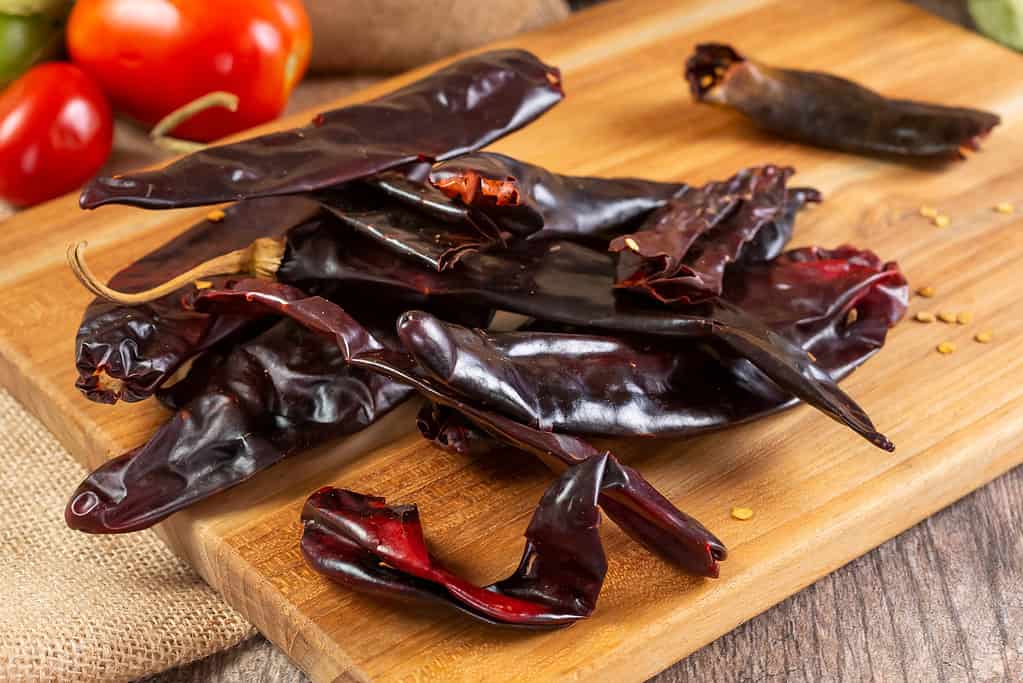
Guajillo peppers pack a lot of Vitamin C.
©iStock.com/Photography By Tonelson
The ‘Guajillo’ pepper is one of the most popular and widely consumed hot peppers in Mexico. This flavorful hot pepper is commonly dried and used in soups or crushed into a powder to flavor various dishes. These peppers typically reach 3-5 inches long and are harvested once they turn red.
Scoville Rating: The Guajillo pepper packs a pleasantly spicy punch with a Scoville rating of 2,500-5000 SHU.
3. Jalapeno Pepper (Capsicum annuum ‘Jalapeno’)
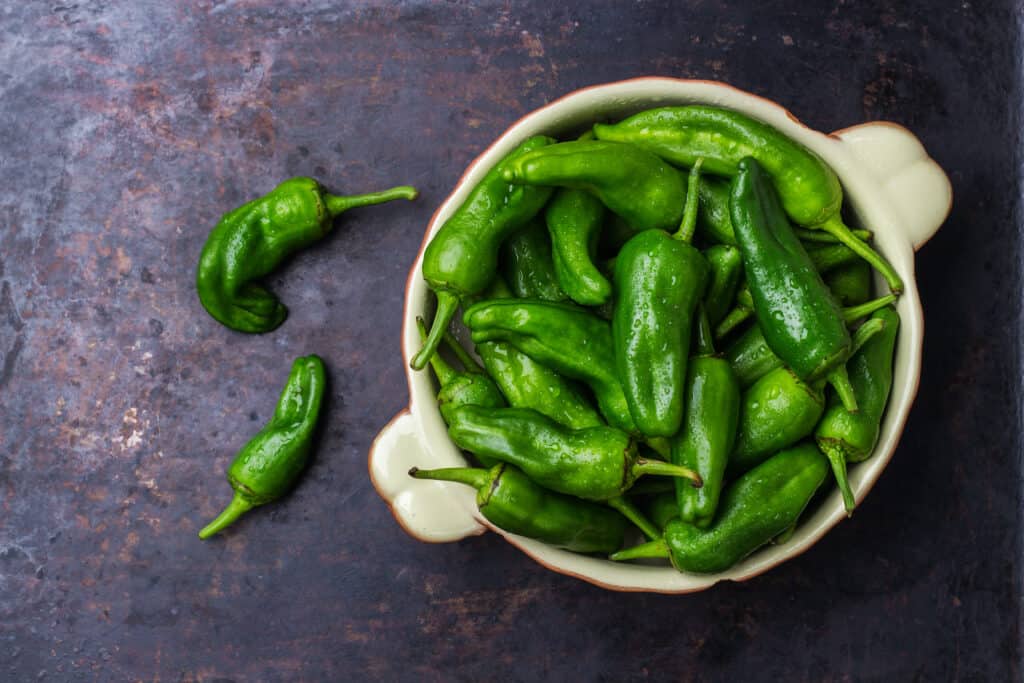
Jalapenos are used throughout international cuisine.
©Antonina Vlasova/Shutterstock.com
While the jalapeno pepper originated in Mexico, it has since become a widely popular ingredient in a variety of cuisines around the world. In particular, these types of hot peppers are common in Mexican, Thai, and American Southwest dishes. Typically, jalapenos are harvested and consumed while they are still green. They are often considered moderately spicy. This variety of C. annuum is small, averaging 2-3 inches long.
Scoville Rating: The Scoville rating varies based on the cultivar and when the pepper is harvested for jalapeno peppers. The rating for this pepper is usually between 2,500-8,000 SHU.
4. Serrano Pepper (Capsicum annuum ‘Serrano’)

Serrano peppers are potent and spicy.
©Brent Hofacker/Shutterstock.com
Originating from the mountainous Mexican states of Hidalgo and Pueblo, the serrano pepper is a potent, flavorful hot pepper that shines in fresh, bright dishes. These spicy fruits are quite small, averaging 1-4 inches long and about 1/2 inch wide. People harvest these peppers at the green or red stage of their ripeness.
Scoville Rating: Many folks consider the serrano pepper to be mild-moderately hot with a Scoville rating, depending on the cultivar and other growing conditions, of 10,000-25,000 SHU.
5. Cayenne Pepper (Capsicum annuum ‘Cayenne’)
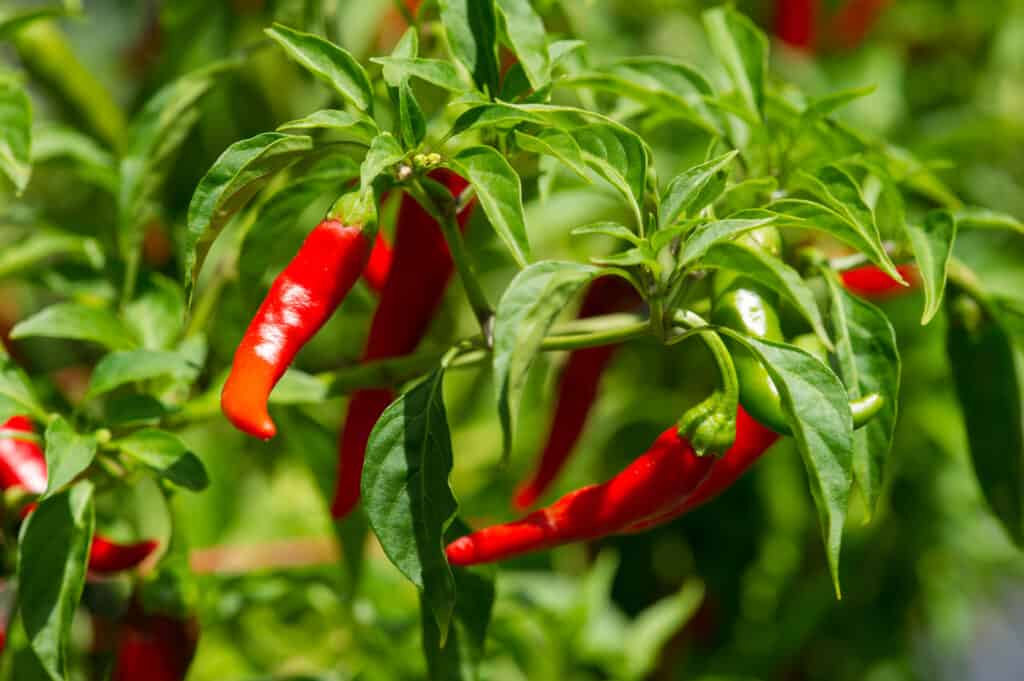
The cayenne pepper is often harvested when it’s bright red and measures 2-5 inches long.
©Peter Acker/Shutterstock.com
A pungent little pepper widely used worldwide as a powdered spice, the cayenne pepper may have originated in or near the South American region of French Guiana. People usually harvest this pepper when it’s bright red and between 2-5 inches long. You may see the cayenne pepper classified as Capsicum frutescens, but the fruit of frutescens species grow and remain upright when mature, rather than hanging down from the stems. Cayenne peppers do not mature in this upright manner.
Scoville Rating: This popular spice pepper packs quite the punch with a Scoville rating of 30,000-50,000 SHU.
6. Malagueta Pepper (Capsicum frutescens ‘Malagueta’)

Malagueta pepper originates from Brazil.
©iStock.com/F de Jesus
A staple hot pepper in its home region of Brazil, malagueta peppers are harvested green or red and used fresh or in cooked dishes. These little peppers tend to reach a maximum length of 2 inches. As a cultivar of the frutescens species, the malagueta peppers mature upright on bushy plants. In addition to their culinary value, they’re also quite ornamental.
Scoville Rating: These little fruits bring some serious heat with a Scoville rating of 60,000-100,000 SHU.
7. Scotch Bonnet Pepper (Capsicum chinense ‘Scotch Bonnet’)

Scotch bonnet peppers may smell sweet but they pack a serious heat punch.
©iStock.com/jchizhe
The Scotch bonnet pepper is a major agricultural export of Jamaica and a staple ingredient in many Caribbean dishes. Often compared in spiciness levels to the habanero pepper (also a chinense cultivar), the Scotch bonnet pepper is definitely not for those with mild taste buds. Folks usually harvest this squat, small pepper when it’s either yellow or orange. It has an almost deceptively sweet scent.
Scoville Rating: Scotch bonnets really ramp up the capsaicin heat levels with a Scoville rating of 125,000-300,000 SHU.
8. Raja Mirch Pepper (Capsicum chinense ‘Raja Mirch’)
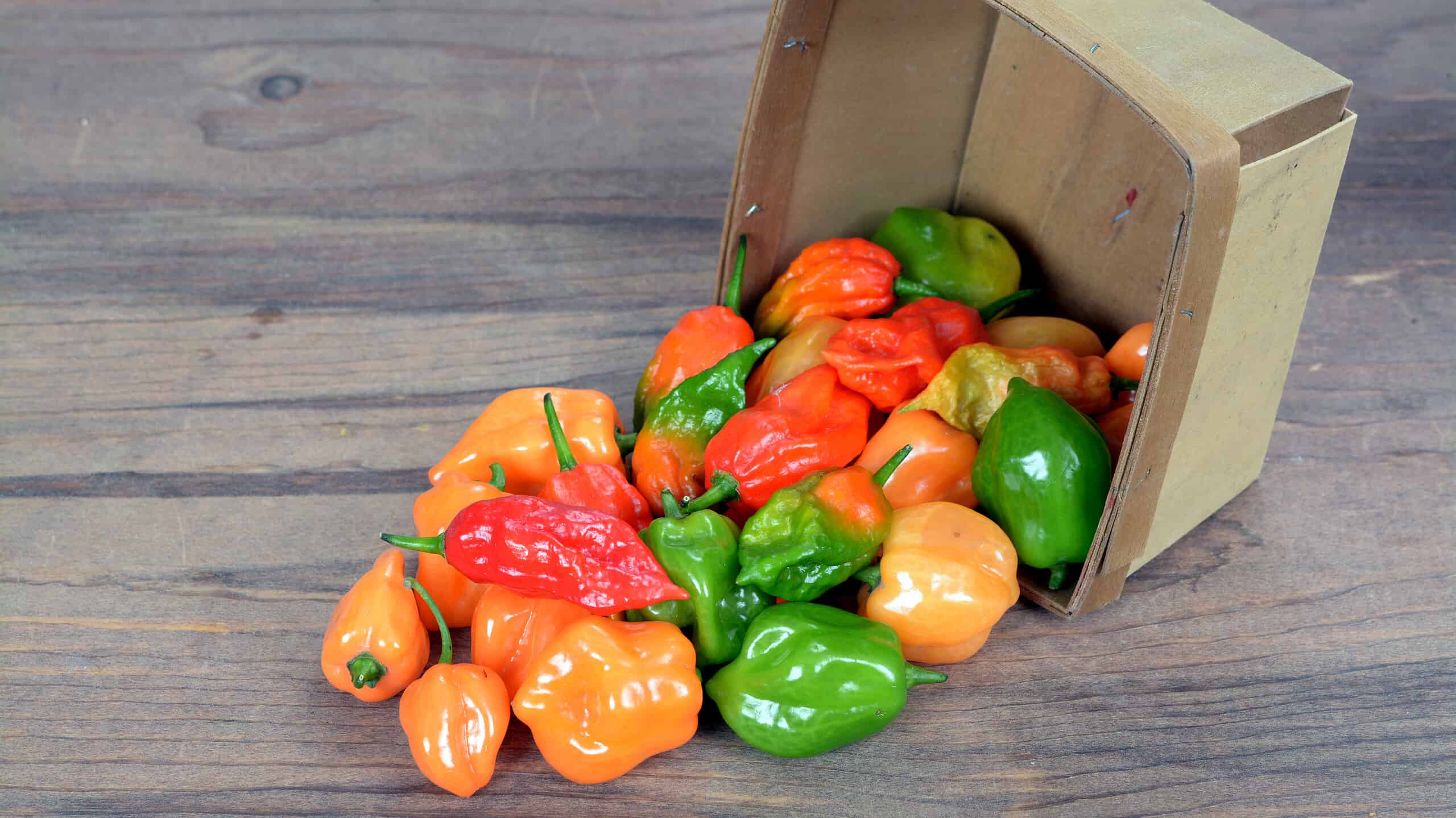
Raja Mirch is also known as the Ghost Chili and Bhut Jolokia.
©AN NGUYEN/Shutterstock.com
An Indian cultivar of the very hot chinense species, the ‘Raja Mirch’ pepper was created with serious heat in mind. As an Indian cultivar, this pepper is often used in extremely spicy chutneys and curries. Additionally, some also pickle this scorching pepper to add a punishing punch of heat to various dishes.
Scoville Rating: This wildly hot little pepper (averaging 2-3 inches in length) has a Scoville rating of 450,000-900,000 SHU, depending on the growing conditions.
9. Trinidad Red Scorpion Pepper (Capsicum chinense ‘Trinidad Red Scorpion’)
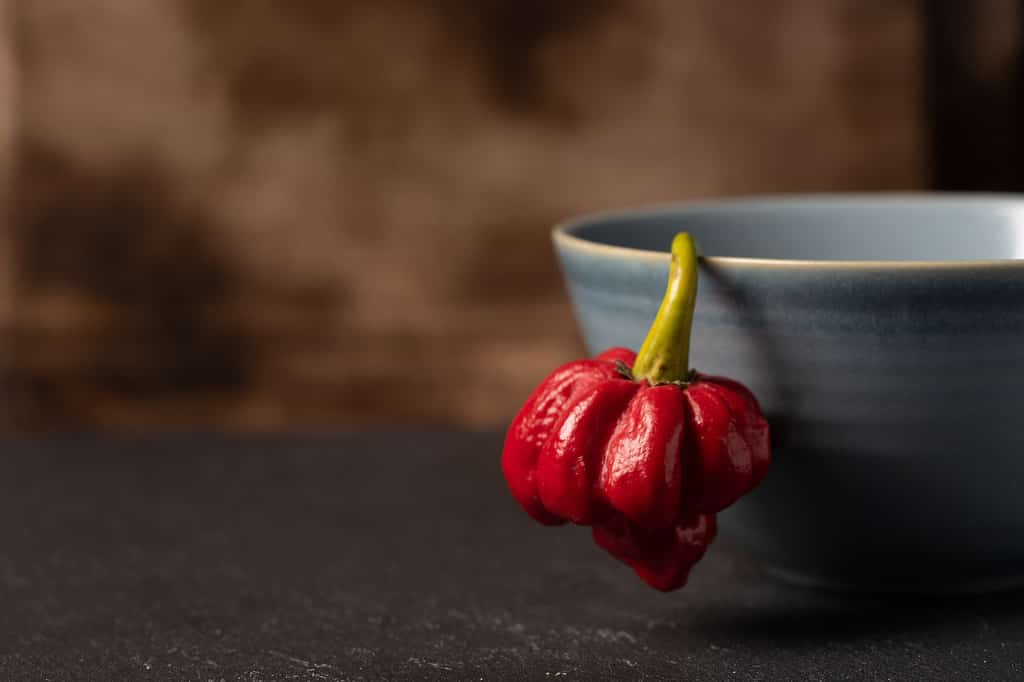
The Trinidad
Scorpion
Moruga is from Moruga, Trinidad, and Tobago.
©iStock.com/Marco Garcia
Several Trinidad scorpion pepper cultivars exist, all extremely hot, packed with flavor, and quite punishing. The ‘Trinidad Red Scorpion’ pepper will burn its way through your GI tract with its searing heat. Most spice-loving folks only dare to put a drop or two of hot sauces that contain this fiery pepper on their food.
Scoville Rating: At number nine on our list, you’d better be cruisin’ for a bruisin’ if you want to tangle with this tasty terror. The ‘Trinidad Red Scorpion’ pepper boasts a Scoville rating of 500,000-1,390,00 SHU.
10. Carolina Reaper Pepper (Capsicum chinense ‘Carolina Reaper’)
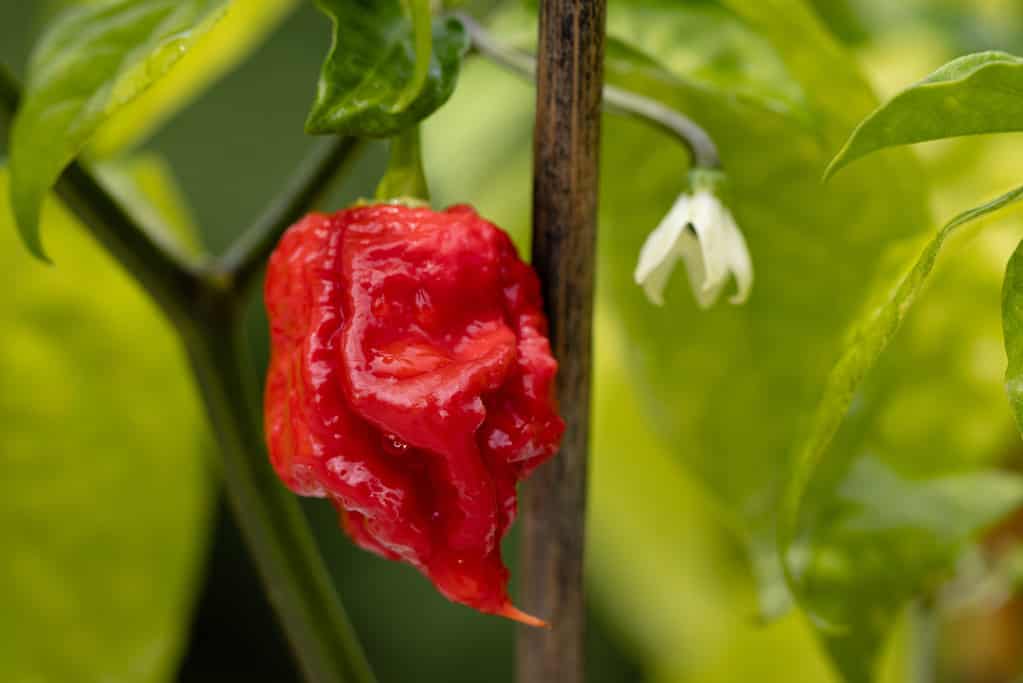
The Carolina Reaper pepper is the hottest pepper in the world, according to the Guinness Book of World Records.
©iStock.com/Wirestock
When a chili pepper contains the word “reaper” in its name, you know it’ll push your taste buds (and willpower!) to the limit. According to the Guinness Book of World Records, the ‘Carolina Reaper’, originating in South Carolina, is currently the hottest pepper in the world. Created by Ed Currie, aka Smokin’ Ed, of the PuckerButt Pepper Company, the ‘Carolina Reaper’ was masterfully crafted to sear your senses with its mind-boggling concentration of capsaicin.
Scoville Rating: This infamously hot pepper comes blazing into our top spot of hottest pepper with a Scoville rating of 1,500,000-2,200,000 SHU.
Summary Of The 10 Types of Hot Peppers
| Rank (Hot to Hottest) | Hot Pepper | Scoville Rating/Unit |
|---|---|---|
| 1 | Anaheim | 500-2,500 Scoville heat units |
| 2 | Guajillo | 2,500-5000 SHU |
| 3 | Jalapeno | 2,500-8,000 SHU |
| 4 | Serrano | 10,000-25,000 SHU |
| 5 | Cayenne | 30,000-50,000 SHU |
| 6 | Malagueta | 60,000-100,000 SHU |
| 7 | Scotch Bonnet | 125,000-300,000 SHU |
| 8 | Raja Mirch Pepper | 450,000-900,000 SHU |
| 9 | Trinidad Red Scorpion Pepper | 500,000-1,390,00 SHU |
| 10 | Carolina Reaper | 1,500,000-2,200,000 SHU |
The photo featured at the top of this post is © iStock.com/F de Jesus
Thank you for reading! Have some feedback for us? Contact the AZ Animals editorial team.






